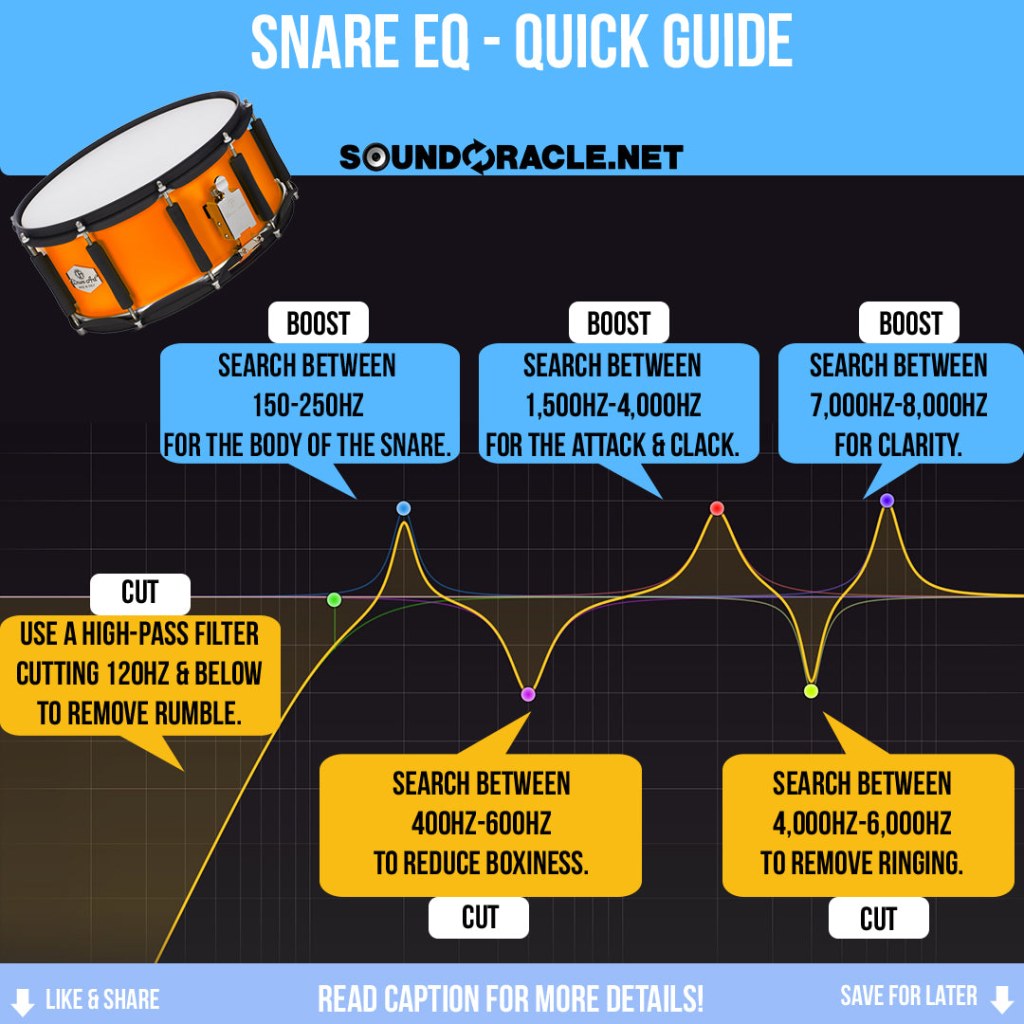Snares Drum EQ Cheat Sheet: Mastering the Perfect Sound
Greetings, Music Enthusiast!
Welcome to our comprehensive guide on snare drum EQ! As a drummer, you understand the importance of achieving the perfect sound for your snare drum. Whether you’re playing in a live performance or recording in the studio, EQing your snare drum can make a world of difference. In this article, we will provide you with a useful cheat sheet to help you master the art of snare drum EQ and achieve the best possible sound.
Introduction

Image Source: soundoracle.net
1. What is snare drum EQ?
Snare drum EQ refers to the process of manipulating the frequencies of the snare drum through equalization. By adjusting the different frequency bands, you can enhance or attenuate specific elements of the snare drum’s sound, such as the attack, body, or resonance.
2. Who should use a snare drum EQ cheat sheet?
Snare drum EQ cheat sheets are beneficial for drummers of all levels, from beginners to professionals. Whether you’re just starting or looking to refine your sound, having a cheat sheet can serve as a helpful reference to guide you through the EQ process.
3. When should you use snare drum EQ?
You can use snare drum EQ in various situations, including live performances, studio recordings, and even during rehearsals. EQing your snare drum can help you cut through the mix, improve clarity, and achieve a balanced sound.
4. Where should you apply snare drum EQ?
The specific frequency bands you should focus on when EQing your snare drum will depend on the sound you want to achieve. Generally, you’ll want to pay attention to the low, mid, and high-frequency ranges to shape the snare drum’s tone effectively.
5. Why is snare drum EQ important?
EQing your snare drum allows you to tailor its sound to fit the genre, venue, or recording environment. It helps you remove unwanted frequencies, highlight specific characteristics, and ensure that your snare drum sits well in the overall mix.
6. How to use a snare drum EQ cheat sheet?
A snare drum EQ cheat sheet provides you with a quick reference guide on which frequency bands to adjust and how to achieve the desired sound. It serves as a helpful starting point and can be customized based on your preferences and the specific snare drum you’re working with.
Snare Drum EQ Cheat Sheet
Now that we understand the basics of snare drum EQ, let’s dive into our comprehensive cheat sheet to help you achieve the perfect sound. Keep in mind that these settings may vary depending on your equipment and personal preferences.
Frequency Range
Adjustment
30Hz – 100Hz
Boost for added depth and resonance or cut for a tighter sound
100Hz – 250Hz
Boost to enhance the body or cut to reduce muddiness
250Hz – 800Hz
Boost for added attack or cut to reduce boxiness
800Hz – 2kHz
Boost for increased presence or cut to reduce harshness
2kHz – 5kHz
Boost to enhance the snare crack or cut to reduce sibilance
5kHz – 10kHz
Boost for added brightness or cut to reduce harshness
Above 10kHz
Boost for added clarity or cut to reduce unwanted high-frequency noise
Advantages and Disadvantages of Snare Drum EQ
1. Advantages of Snare Drum EQ
Enhanced control over the snare drum’s sound
Ability to tailor the snare drum to fit different genres and settings
Improved clarity and definition in the mix
Reduced unwanted frequencies and resonances
Highlighting specific characteristics of the snare drum
2. Disadvantages of Snare Drum EQ
Potential loss of natural character if overdone
Requires a good understanding of frequency ranges and EQ techniques
May require experimentation and adjustments to achieve the desired sound
Frequently Asked Questions (FAQ)
1. Can I use the same snare drum EQ settings for every song?
No, the optimal snare drum EQ settings may vary depending on the song, genre, and desired sound. Experimentation and customization are key to achieving the best results.
2. Should I EQ my snare drum before or after recording?
It’s generally recommended to spend time EQing your snare drum during the recording process to capture the desired sound. However, you can also make adjustments during the mixing stage if needed.
3. Can I use a snare drum EQ cheat sheet for other drums?
While the frequency ranges may differ for other drums, the concept of EQing to shape the sound remains the same. You can adapt the cheat sheet principles to other drums by adjusting the frequency ranges accordingly.
4. What EQ plugins or hardware should I use for snare drum EQ?
There are various EQ plugins and hardware available that can be used for snare drum EQ. Some popular options include parametric EQs, graphic EQs, and channel strip EQs. Experiment with different tools to find what works best for you.
5. Can I achieve a good snare drum sound without EQ?
While EQing can greatly enhance your snare drum sound, it’s still possible to achieve a good sound without extensive EQing. Proper tuning, microphone placement, and drum selection are also crucial factors in achieving a great snare drum sound.
Conclusion
In conclusion, mastering the art of snare drum EQ is essential for any drummer aiming to achieve the perfect sound. By using our comprehensive cheat sheet and understanding the principles of snare drum EQ, you can enhance your drumming performances and recordings. Remember to experiment, trust your ears, and make adjustments based on your specific drum and musical context.
Final Remarks
Disclaimer: The information provided in this article serves as a general guide for snare drum EQ. The specific EQ settings may vary depending on your equipment, personal preference, and the desired sound. It’s important to trust your ears and make adjustments accordingly. Always consider the context and musical requirements when applying EQ to your snare drum.